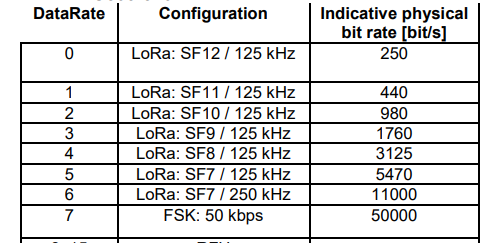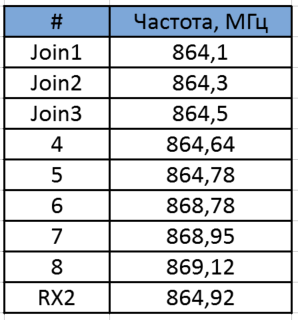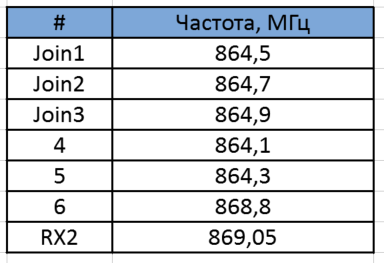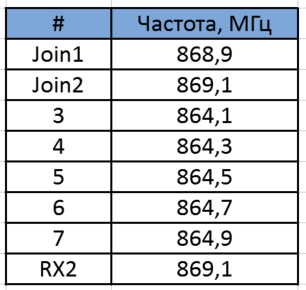Notes IoT provider. About frequency
Hello, dear lovers of Internet Things!
First part → Second part → Third part → Fourth part → Fifth part → Sixth part
→ Seventh part
Periodically questions arise about the regulator and frequency plans. With the release of specification 1.1 and the transition to it, the confusion has become even greater. Let's try to figure it out.
As we all remember, LoRaWAN can use channels of different widths, but 125 kHz have taken root in Russia. There are options to use 250 or even 500 kHz, but in our reality it is too much luxury. Although it is exactly by half of the megahertz that it’s really possible to squeeze out those very peak 50 kilobits / sec that people like to write about in beautiful booklets.
The width of less than 125 kHz is not provided by the specification, although the chip can implement it in a purely circuit design.
')
The possible channel widths, SF and speeds are shown below. This is also a specification 1.02 version for Europe.
So, we use 125 kHz. What we have with the law, what can be used in the range of 868 MHz?
To answer this question, let’s refer to this decision of the GKRCH - minprom.ru/reshenie-gkrch-07-20-03-001-ot-07-05-2007
The Ministry of Communications allows us to work in the following subranges with the following restrictions.
I want to especially draw your attention to the fact that we have 25 mW - this is not the transmitter power, as many people think. This eirp is the effective isotropic radiated power. In simple terms, this is transmitter power, minus cable and connector losses, plus antenna gain. Formally, with a good antenna, we can slightly exceed the permissible level. In fact, measurements on the ground at such facilities will give too much error, and calculations also may not reflect the whole picture. It is usually taken that the cable and connectors are compensated by the antenna and are repelled by the transmitter power. Let us and we will do the same.
We have two subranges - 1 MHz and 0.5 MHz. There will fit 7 channels of 125 kHz, since between them we still have to leave a gap of 75 kHz (Semtech recommendation).
Now what? How do we arrange these channels by frequency?
To this question, each hardware manufacturer answered differently.
Until this spring, there were three of the most popular frequency plans in Russia:
1) European PE.
Many operators simply did not bother and put the equipment in the way it came from China or Europe, on the default frequency plan. He, as a rule, was EU-868 and violated Russian legislation.
2) Smartiko's state of emergency. In October 2016, the Russian operator and manufacturer of equipment Smartiko proudly announced that he had agreed with all IoT providers and approved a national state of emergency. The truth is not entirely clear with whom they agreed. In addition, the state of emergency violated the recommendations of the Semtech company about gaps between channels of 75 kHz. Nevertheless, such an emergency could be found.
3) PE Vega. The most popular was the emergency proposed by the Russian manufacturer of equipment LoRa, the company Vega. Here he met the requirements of the legislation and recommendations of Semtech. The problem is that, due to the requirements of the law and compliance with the recommendations, only 7 channels fit in this emergency.
Such confusion arose due to the fact that the regional specification specification 1.02 did not yet contain Russia.
A little later, in October 2017, specification 1.1 is released. There Russia is already there, though the state of emergency is very strange. Here he is:
As you can see, here the second receiving window of the RX2 for some reason coincides with one of the join frequencies. Nevertheless, this is the decision of the Alliance, which means it must be obeyed.
Gradually, Russian companies began the transition to a new state of emergency.
For operators who already had existing subscribers and installed devices, this became a real headache. Yes, LoRa haters can be happy, the inability to remotely change the emergency on the device or reflash it is really a problem.
Those who had LoRa in the pilot didn’t have any problems, and that’s it.
We have the greatest difficulties in Chelyabinsk, where the BS is already a lot and subscribers scattered around the city. For translation, I had to deploy two networks at different frequencies. Old devices were re-flashed by hand, new ones were already installed on a new emergency. That is still a story, although this was expected. At the moment, the process is almost complete and we are preparing to pay off the “old network”.
Someone may ask - why such difficulties for the sake of the requirements of the Alliance? To wave a hand at them and work as before.
No, that won't work. The farther, the more devices with LoRa support will appear. Guess what state of emergency they will support in the near future? What frequencies will be used by default?
Yes, for sure there it will be possible to drive in custom frequencies, but why create extra problems for yourself? As long as the devices count goes to tens and hundreds of them can still be reflashed and continue to live in harmony with the specification. If in the future the bill will go to thousands, then with its non-standard PE will be tight. This is the decision of each operator, we decided not to go across the progress.
Moreover, standardization is always right. It means that the technology is claimed by a large number of consumers and the general rules of the game are introduced to avoid chaos.
Source: https://habr.com/ru/post/422097/
All Articles